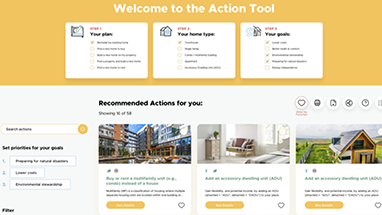
Play Video
Introduction

Play Video
Getting Started I

Play Video
Getting Started II
THE VIDEOS ARE IN DEVELOPMENT. PLEASE CHECK BACK LATER.
The Action Tool is the heart of the website. It includes our picks for the top
64+ things to think about with regards to your home. Of course, they won’t all be applicable
to you, but we encourage you to keep an open mind and consider each one.
Overview
- Starting on the home page, selecting your “plan” (like “Buy a new home”) will kickoff the guide where you’ll be asked a couple of simple questions (one about your home type and one about your goals). Note: You can bypass these steps by using the search field at the top of the page.
- When you arrive to the Action Tool your selections will be displayed and the “Actions Recommended for You” are shown on the page.
- You can fine-tune or sort the results using the additional filters on the left.
- Add an action to your “Favorites” by clicking on the heart icon.
- Mark an action “complete” or “not applicable” by clicking the icon in the action. This will hide the action. Tip: Want to see your progress? You can choose to show all the completed actions by clicking the “Show completed actions” checkbox on the left-hand side of the Action Tool page.
- “Top Choice!” indicates the actions we recommend for nearly everyone, as they require little (or no) investment. Some will even save you money instantly!
- Need to make changes? No problem. Make the changes, then click “Apply Changes”.
- Reset the filters at any time by clicking the “Reset All Filters” button.
- Click an Action to learn more about it.
Pro tip: If you aren’t building from scratch, or remodeling, look for homes (or buildings, for condos/apartments) where the actions you like have already been done.
For example, If “Install LED lighting” is on your list then wouldn’t it would be cheaper and easier to find a home that already has LEDs? This is especially true for renters who have less ability to make changes to their unit/building.
Print, Save, Share
Utilize these features to save your searches, and collaborate with others:

Print: This is a standard feature on your device, which allows you to “save to pdf” or print a hard copy of the results that you have obtained.
Save: Sorry. This feature is unavailable until accounts are needed on the site.
Share: You can share your searches and add a message. The recipient will receive an email with a link to the search results along with a message, if desired. Use this with the ‘Save’ functionality above. For example, if you want to share your search with your agent you could save your search and then share the same results with your agent.
Glossary
Initial Cost:
- n/a (instant savings!)
- n/a (no cost)
- $ Low $1 – $499
- $$ Medium $500 – $4,999
- $$$ Med/High > $5,000 – $9,999
- $$$$ High 10,000 – $25,000
- $$$$$ Very High > $25,000
Return on Investment (ROI):
- Very High < 5 years
- High < 5 - 6 years
- Medium 7 – 8 years
- Low 9 – 10 years
- Very Low > 10 years (or not applicable)
Of course some Actions might initially cost a lot but pay back quickly. For example, solar panels have a high initial cost but typically pay back quickly (they often have a medium-high ROI).
Health & Comfort Benefit: This is a measure of how much the Action (directly or indirectly) increases human health (better indoor air quality, better daylighting, clean drinking water…) and comfort (better insulated so spaces more often maintain desired temperatures, more views to outdoors, less space to clean etc).
Climate Benefit: This is a measure of how much the Action (directly or indirectly) helps reduce greenhouse gas emissions such as CO2 into the atmosphere, reducing the negative effects of increasing global temperatures (i.e., climate change). Some are obvious, such as installing heat pumps instead of gas furnaces. Others are less obvious, such as hiring a green building consultant, or working with an agent who is experienced in finding their clients more sustainable homes.
Environmental Benefit: This is a measure of how much the Action (directly or indirectly) has a positive effect on the environment. Some are obvious, such as building smaller homes, or the electrification of your home to help us move away from fossil fuels. Others are less obvious, such as limiting green lawns to avoid pesticides and fertilizers from running into local waters.
Resilience Benefit: This is a measure of how much the Action gets a home ready for disasters such as earthquakes, hurricanes, floods, wildfires, tornadoes, power grid issues. The better prepared our homes are for such crises, the better we will come out of them. With climate change and other conditions bringing us more frequent/intense events such as these, it is becoming increasingly important to focus on building resilient structures.
Social Equity Benefit: This is a measure of how much an Action improves social equity, social justice, environmental justice etc. If “Environmental Benefit” is for the planet, “Social Equity Benefit” is for the people. Some are obvious, such as buying fair trade materials, or products not made using child labor. Others are less obvious, such as building a detached accessory dwelling unit (DADU) in your backyard and renting it out, to help reduce a housing shortage in your city.
DISCLAIMER: We’ll be the first to admit that the initial cost, ROI, and “benefit” ratings above include more than a few educated guesses. That said, our team has done their best to rate each Action as accurately as possible, considering U.S. averages. The Rūvtop team understands that there are Actions that you would rate differently based on your experience, where you work or live, and the assumptions you may make. Bottom line, don’t take the ratings too literally – Our primary goal is that they will be helpful to most people most of the time with regards to prioritizing their goals (or those of their clients). And, of course, your feedback is always welcome.
Diagram of website elements


